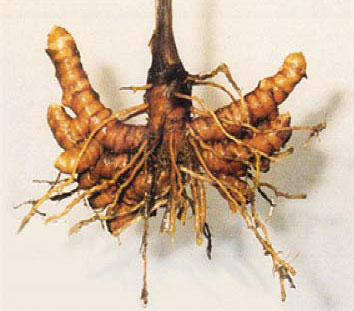Abstract
The healthful spice turmeric, has traditionally been used in skin care since ancient times in South Asia. Recent scientific research has validated its inherent beneficial effects, both nutritional and topical. Technological innovation in ingredients enables imparting the goodness of curcuminoids from "curry", (turmeric) into skin, hair and nails without being hampered by the yellow color. Tetrahydrocurcuminoids (a) are patented colorless derivatives of the yellow "bioprotectant" curcuminoids (b) with multifaceted benefits in anti-aging and skin protectant compositions. This article discusses innovative applications of the natural compositions of Curcuminoids and Tetrahydrocurcuminoids, as well as a single component Tetrahydrocurcumin.
Introduction: skin aging and antioxidants
Aging is attributed to the effects of collective damage to connective tissues, that overpowers the body's natural ability to repair them. The perceptible signs of skin aging include discoloration, wrinkles, and texture loss. These effects result from structural and metabolic changes effected by biochemical reactions in the connective tissues, that are accelerated by free radicals. Environmental agents such as UV rays exacerbate the effects of free radical reactions and oxidative stress. These reactions to time and the environment are rooted in the metabolic processes in the body, and the ability of the internal machinery to combat stress and adapt to the environment (1, 2). About 25 percent of the lipids in the skin surface are unsaturated, and therefore more prone to attack by free radicals. These reactions in turn promote the action of inherent enzymes such as collagenase and elastase, facilitating the proliferation of inflammatory mediators. Apparent deteriorative oxidative changes triggered by free radicals include wrinkling, hyperpigmentation (excessive tanning) and inflammation (sunburn). Free radicals attack the skin's fibroblasts, leading to loss of collagen and elastin; and cause cross-linkage of connective tissue fiber. The result is dry, leathery skin, with wrinkled appearance and poor skin tone. Aged skin may be manifested in the form of discoloration, actinic keratosis (rough, reddish warts on sun-exposed areas, a precursor to "squamous cell carcinoma"), seborrehic keratosis (non-cancerous brown or black raised spots), cherry angiomas (small, bright red domes due to dilated blood vessels), and broken capillaries (bruising due to dilated blood vessels and loss of subcutaneous fat), as well. "Anti-aging" cosmetic products, potentially inhibit or delay the visible signs of chronoaging and photoaging, such as wrinkles, lines, sagging, hyperpigmentation and age spots. Recent trends favor attacking the root causes of aging from the inside and the outside for consolidated benefits. Nutricosmetics in the form of dietary interventions work with externally applied cosmeceuticals to slow down the aging process. Natural antioxidants that quench free radicals are an essential component of anti-aging formulations. They potentially offer protection against damage to the tissues by environmental and other agents. Biochemical reactions that accelerate the progression of skin aging have their roots in inflammatory processes. Inflammation generates microscars which mature into blemishes or wrinkles. Various types of inflammatory mediators such as leukotrienes and prostaglandins, cytokines and growth factors may influence melanin synthesis by affecting the proliferation and functioning of melanocytes. Protein kinase C, the enzyme, that phosphorylates proteins, may also influence the growth and differentiation of melanocytes. Cytokines such as endothelins (also known as vasoconstrictive peptides) are also reported to accelerate melanogenesis. Natural antiinflammatory agents are therefore included in antiaging formulations, and serve to soothe, heal and protect skin tone and integrity. Lipids play an important role in maintaining the barrier functions of the skin. In general, unsaturated fatty acids reinforce the skin's barrier function, prevent moisture loss through the epidermis, provide structural integrity to the skin damaged by external influences and are antiinflammatory. They also help to soften and smoothen the skin by inhibiting the formation of corneous cells. Lipid compounds that provide an occlusive effect to prevent water loss, repair lipid layers and restore barrier functions are therefore an integral part of antiaging formulations.
Curcuminoids: antioxidant phytonutrients from turmeric
Curcuminoids-rich extract from turmeric rhizomes is well known for its antioxidant properties, antimicrobial effects, and beneficial effects on inflammation. Turmeric has been traditionally used by South Asian women in skin care since ancient times. However, its yellow color may not blend well with cosmetic formulations. An innovative colorless (white to very light tan) derivative, Tetrahydrocurcuminoids, addresses this drawback, and offers effective protection against sun damage. Its antioxidant action is of a comprehensive "bioprotectant" nature, efficiently preventing the formation of free radicals, while quenching pre-formed ones as well, thereby protecting the skin cells from damage by UV radiation and the resultant inflammation and injury. This in turn has far reached beneficial effects on overall health and well being, rendering a healthy glow to the skin. Tetrahydrocurcuminoids are therefore useful in brightening and lightening skin tone, and offer protection against the development of melanoma (1, 8, 9). The bioprotectant effect of curcuminoids (4) and tetrahydrocurcuminoids is further validated in welldocumented experiments related to anti-tumor activity. The addition of 0.5 to 10 micromoles of curcumin to an in vitro skin cell culture inhibited the activity of the enzyme ornithine decarboxylase which has been linked to the promotion of tumor cell growth. Thus curcumin has the capability to inhibit genetic change (mutation) in the cells, that often initiates the aging process, and contributes to cancer development. Traditionally, turmeric from which curcuminoids and tetrahydrocurcuminoids are derived, has been used in the ancient system of Indian medicine, Ayurveda in a variety of internal and topical uses. Documented traditional topical uses include application to the ear in chronic otorrhea, as a cooling eyewash to relieve purulent opthalmia, as a topical treatment for pemphigus (an allergic and inflammatory skin condition), in viral conditions such as shingles and chickenpox to facilitate the process of healing, and as a dressing applied to bruises, sprains, found that curcuminoids can be effectively applied in the treatment of precancerous lesion called leukoplakia (usually affecting oral mucosa).

Based on their history of traditional use in Ayurvedic medicine, and the relatively recent research findings on their safety and efficacy, the multifunctional curcuminoids, and their metabolite tetrahydrocurcuminoids, deserve a special place among natural cosmeceuticals.
Curcuminoids exert benefits at the molecular level
At the fundamental level, phytonutrients such as curcumin have been shown to up regulate antioxidant gene expression in animal models. The multifunctional health benefits of the curcuminoids are well researched and these antioxidant compounds are potentially useful in preventing inflammation and several types of cancer. A common spice used in South Asian cooking, turmeric and more appropriately the curcuminoids have been preclinically and/or clinically validated for beneficial effects in a number of disease conditions ranging from Alzheimer's disease to cystic fibrosis. The antioxidant effects of curcuminoids combined with their known inhibitory effects on cyclooxygenase 2 (COX-2) render them useful as ingredients in anti-aging formulations, and in topical formulations designed to maintain general skin health and integrity. Oxidative stress and inflammation are major players in the aging process. The antiinflammatory role of curcuminoids is well established. Curcuminoids have been shown to inhibit nuclear factor kappaB (NF B) a transcription factor that triggers inflammatory mediators. NF B has been implicated in a variety of chronic disease conditions ranging from cardiovascular diseases to cancer (3). A recent study postulates that curcumin can potentially slow down the aging process, delaying senescence and the onset or progression of many age-related diseases. Curcuminoids offer antioxidant support, antiinflammatory support, support a healthy immune system, prevent connective tissue break down through inhibiting destructive enzymes (such as collagenase, elastase, hyaluronidase) (8).
Tetrahydrocurcuminoids: the "white" curcuminoids
This composition (5, 6) is a colorless hydrogenated derivative of the natural yellow curcuminoids (curcumin, demethoxycurcumin, bisdemethoxycurcumin, from Curcuma longa (Turmeric)). The components Tetrahydrocurcumin (INCI: Tetrahydrodiferuloylmethane), Tetrahydrodemethoxycurcumin (INCI: Tetrahydrodemethoxydiferuloylmethane), and Tetrahydrobisdemethoxycurcumin (INCI: Tetrahydrobisdemethoxydiferuloylmethane) are reported to be major metabolites of curcuminoids in vivo. For example, Curcumin the major curcuminoid in the natural extract is biotransformed in the body through reduction to Tetrahydrocurcumin and other reduced forms (8, 9).
Several independent studies reported the significant antioxidant effects of Tetrahydrocurcuminoids and their utility in achromatic food and cosmetic applications that currently employ conventional synthetic antioxidants. Tetrahydrocurcuminoids was shown to be a more efficient antioxidant than the curcuminoids, curcumin, and vitamin E in laboratory studies. The concentration of Tetrahydrocurcuminoids needed to scavenge free radicals (IC50) was 2.3, 2.7 and 5.8 times lower than that of Curcuminoids, Curcumin and vitamin E, respectively (8).
Tetrahydrocurcuminoids inhibit cross linking of proteins, supporting healthy aging. Described as a "crossregulin" composition, this natural ingredient is effective in skin lightening, and offers protection against UVB rays, melanoma, and age spots. Tetrahydrocurcuminoids also support skin texture through inhibitory effects on enzymes that help to break down connective tissues. The composition also effects skin lightening effects through tyrosinase inhibition. A branded Tetrahydrocurcumin product (patents pending) was found to be several fold more effective as a skin lightener than other natural skin lightening agents including glabridin (licorice extract) and kojic acid. The comparative tyrosinase inhibitory activity of these natural materials is summarized in Table 1 (7):

Applications in cosmetics
Some of the cosmeceutical applications of Tetrahydrocurcuminoids are as below. The suggested level of use in such formulations is 0.5 percent to 2 percent w/w.
- Dyschromia management support
- Skin tone lightener
- Protection against UVB (sun care, after-sun care)
- Antiaging Support
- Antioxidant (both as functional antioxidant to prevent fat oxidation in the formulation and as a
"cosmeceutical" antioxidant) From the safety point of view, the bioprotectant role of Tetrahydrocurcuminoids is further enhanced by its very low toxicity, (oral LD50 is 5000 mg/kg) with a 0.00 irritation score in a skin patch test. It does not sensitize the skin. Turmeric root, the source of Tetrahydrocurcuminoids, is listed by the US Food and Drug Administration (FDA) as an herb generally recognized as safe (GRAS) for its intended use as a spice, seasoning and flavoring agent (21 CFR 100.0, 182.10, 182.20).
Sample formulations for cosmetic and nutricosmetic applications are presented here.
Cosmetic formulation: skin lightening "Antiaging" formula
| Ingredient Function | % Wt. |
| Phase A | |
| Deionized water Solvent | 82.10 |
| Xanthan gum Stabilizer | 0.60 |
| Phase B | |
| Caprylic/capric triglyceride Emollient/Solvent | 3.00 |
| Myristyl myristate Emollient | 3.00 |
| Cetyl alcohol Emollient/solvent | 1.50 |
| Emulsifying wax NF Emulsifying agent | 2.50 |
| Sodium methylparaben Preservative | 0.2 |
| Sodium propylparaben Preservative | 0.1 |
| Tetrahydropiperine (Cosmoperine® Active Sabinsa Corp) | 0.01 |
| Phase C | |
| Tetrahydrodiferuloylmethane Active (SabiWhite®, Sabinsa Corp) |
0.5 |
| Oxyresveratrol Active (OxyResvenoxTM, Sabinsa Corp) Rosmarinus Officinalis (Rosemary) |
0.1 |
| Leaf Extract Active (Rosemary CG , Sabinsa Corp) |
0.5 |
| Cyclomethicone Antistatic agent | 3.00 |
Heat water from phase A to 50°C and sprinkle in xanthan gum, mixing well, and then heat mixture to 75°C. Combine ingredients of phase B with mixing and heat to 75°C. Add B to A using agitation, at this temperature, mix for 20 minutes and maintain temperature at 70-75°C. Cool to 40°C, add phase C with mixing and cool to desired fill temperature.
Sample nutricosmetic dietary supplement formulation: Sun protection/After- sun care

Formulate as tablet or capsule with permitted carriers and other inactive ingredients
Suggested use level: 1 tablet or capsule twice daily
References and notes
a. US Patent #6,653,327, EP1171144 and pending International patents
b. US Patent #5,861,415; EP0839037
1. V. Badmaev, M. Majeed, "Tetrahydrocurcuminoids (THC) as a Skin Bioprotectant", Agro-Food-Hi-Tech, Jan.-Feb, pp.25-27 (2000)
2. H. Black, "Potential involvement of free radical reactions in ultraviolet light-mediated cutaneous damage", Photochem. Photobiol., 46, pp. 213-22 (1987)
3. A. Kumar et al., "Nuclear factor-kappaB: its role in health and disease", Journal of Molecular Medicine, 82, pp. 434-48 (2004)
4. M. Majeed et al., US Patent 5,861,415 Bioprotectant composition, method of use and extraction process of Curcuminoids
5. M. Majeed et al., US Patent No. 6,653,327. Cross regulin composition of turmeric-derived tetrahydrocurcuminoids for skin lightening and protection against UVB rays
6. L. Prakash et al., "Multifunctional Ingredients: The Novel Face of Natural", Cosmetics & Toiletries Magazine, 118, No. 11/ November, pp. 41-46 (2003)
7. Research Report, Sami Labs Ltd., 2002
8. www.curcuminoids.com
9. www.tetrahydrocurcuminoids.com










